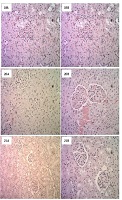Development, characterization, efficacy and repeated dose toxicity of nanoemulsified ethanolic extract of Enicostemma littorale in Streptozotocin-induced diabetes rats.
Keywords:
nanoemulsion, streptozotocin, diabetics, anti-diabetic, Enicostemma littoraleAbstract
Alginate nanocapsules of ethanolic extract of Enicostemma littorale (NEL) were prepared by emulsification, cross linking with calcium chloride and solvent removal. Based on total phenol content the loading efficiency of the nanocapsules was 89% at an optimum concentration of 2: 18 (mg ml -1) for plant extract: olive oil. The photon correlation spectroscopy (PCS) revealed that the mean particle diameter of optimized formulation was 233 nm and scanning electron microscopy (SEM) showed a spherical morphology. When subjected to Fourier transform infrared spectroscopy (FT-IR) for the compatability analysis between plant extract and sodium alginate, it revealed that the phytoconstituents were stable. The purpose of the present study was to compare the anti-diabetic activity of NEL and E.littorale (EL) in streptozoticin induced male rats. An oral dose of NEL (20 mg/kg b.w) and EL (2000 mg/kg b.w) showed a relatively similar antidiabetic effect, reducing the blood glucose, triglycerides, cholesterol, creatinine, ALT, AST, and ALP. Moreover, NEL is 100 times less than EL exhibiting better results within 10 days of treatment. These biochemical assessments were supported by rat biopsy examinations. In conclusion, the nanoemulsification method can be applied for poor water-soluble ethanolic herbal extracts to reduce the dosage and time
References
. Vallabhji J., McColl A.J., Richmond
W., Schachter M., Rubens M.B.,
Elkeles R.S., Total antioxidant status
and coronary artery calcification in
type 1 diabetes. Diabetes
Care.,2001, 24: 1608–1613.
. Zhang X.F., Tan B.K.,
Antihyperglycaemic and antioxidant
properties of andrographis
particulate in normal and diabetic
rats. Clin. Exp. Pharmacol., 2000,
: 5–6.
. Skim F., Lazrek H.B., Kaaya A.,
Elamri H., Jana M., Pharmacological
studies of two antidiabetic plants:
Globularia alypum and Zygophyllum
gaetulum. Therapia., 1999, 54:711–
. Reeves W.B., Andreoli T.E.,
Transforming growth factor-h
contributes to progressive diabetic
nephropathy. Proccedings National
Academic Science, U S A., 2000, 97:
–9.
. Mauer S.M., Steffes M.W., Ellis E.N.,
Sutherland D.E., Brown D.M., Goetz
F.C., Structural–functional
relationships in diabetic
nephropathy. Journal of Clinical
Investment., 1984, 74: 1143– 55.
. Mauer S.M., Lane P., Hattori M.,
Fioretto P., Steffes M.W., Renal
structure and function in insulindependent diabetes mellitus and
type I membranoproliferative
glomerulonephritis in humans.
Journal of Americn Society of
Nephrology., 1992, 2:S181–4.
. Lu M.F., Cheng Y.Q., Li L.J., Wu
J.J., Progress of study on passive
targeting of drug delivery system.
Material Review., 2005, 19: 108–
21
. Sonawane R.D., Viswakarma S.L..,
Lakshmi S, Rajini M., Padh H., Goyal
R.K., Amelioration of STZ – induced
type-1 diabetic nephropathy by
aqueous extract of Enicostemma
littorale Blume and swertiamarin in
rats. Molecular Cell
Biochemistry.,2010, 340: 1-6.
. Bhattacharya S., Phytosomes:
Emerging Strategy in Delivery of
Herbal Drugs and Nutraceuticals,
Pharma Times. 2009, 41: 9–12



